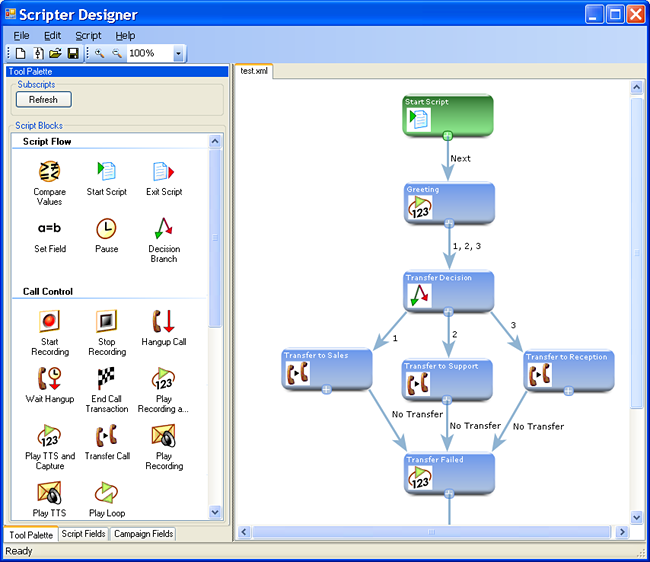This section will describe the concepts of Interactive Voice Response (IVR) and then present the features of Quantrax’s IVR platform. IVR is an area that can si gnificantly enhance the automation levels within your organization. The potential of an IVR ranges from accepting an inbound call and taking simple requests (E.g. “Press 1 to obtain the mailing address for your payment”) to more complex interactive experiences where a series of digitally recorded questions or messages would be played, with the caller being offered different options based on the responses supplied through the telephone keypad. An example would be the setting up a payment arrangement without any agent intervention. A possible sequence of steps could be as follows:
gnificantly enhance the automation levels within your organization. The potential of an IVR ranges from accepting an inbound call and taking simple requests (E.g. “Press 1 to obtain the mailing address for your payment”) to more complex interactive experiences where a series of digitally recorded questions or messages would be played, with the caller being offered different options based on the responses supplied through the telephone keypad. An example would be the setting up a payment arrangement without any agent intervention. A possible sequence of steps could be as follows:
- The caller must be correctly identified using their account number and social security number.
- The total balance is retrieved and announced to the debtor.
- The caller is given a choice of installment amounts (These would be computed by the system based on predefined criteria).
- One of the available options would have to be selected through the telephone keypad.
- The caller’s selection, the installment amount, first installment due date and mailing instructions would be played to the debtor for confirmation.
- The system would document the debtor’s selections and set up the payment arrangement in the same manner as a collector would have, using their workstation. The system could be set up to automatically generate a confirmation letter to the debtor.
IVR is an area that will require customization and training. Combined with digital messaging, you have the option to automate several areas of the debtor interaction process. The system can be set up to allow the debtor to obtain the assistance of an agent at any time in the IVR process. If the call comes in after working hours, the debtor can have the option of leaving a message with a call back time and number. The voice mail can be keyed to the account that was being processed at the time. The value of being able to provide “agentless” support for simple to complex inquiries provides great savings in personnel as well as accuracy of the information that is delivered to the callers. Plus, an IVR solution does not require lunch breaks or vacations!
I-Tel’s implementation of IVR
The above was a general discussion of IVR. Quantrax’s IVR implementation has the following options. These will be expanded in future updates.
- A company would purchase IVR licenses, where one license would represent one “virtual agent”. One “conversation” between a debtor and the IVR would require one virtual agent and therefore one IVR license.
- No additional hardware is usually required, since the product is a part of the dialer platform. We will be utilizing the same dialer server and telephony cards that are used for outbound and inbound calls. The maximum number of simultaneous conversations you expect to handle will determine the number of IVR licenses you will need.
- The IVR will typically replace your initial hunt group logic in an inbound environment. You could look at IVR as a “virtual extension” that does not need to exist on your PBX. You can also use IVR in an outbound dialing environment. An example would be messaging that incorporates TTS (text-to-speech). Listen to a sample recording of an “unattended message” that uses TTS.


- You would first set up a greeting menu – this can be different for different IVR agents (E.g. different 800 numbers would be linked to specific IVR agents). The greeting menu would be a wav. file or a series wav. files for the case where substitution of variable data is practical (E.g. the names of different companies). The greeting menu could be played using text to speech, but that is not recommended due to the significant resource and processing capacity that will be required.
- Once the caller has listened to the greeting menu, the following is possible :
- Another wav. file could be played (E.g. giving more options or a new menu)
- It is possible to invite input from the telephone keypad (E.g. Select 5 to access your account)
- If the caller selects an option that requires an account lookup (unlike an option such as “Select 4 for for the mailing address for payments”), it will be necessary to first authenticate the caller. We can ask for company, case number and the last 4 characters of the SS#. If the input can not be matched to an account, or the social is not on the account, the call is transferred to an agent (through a hunt group). After working hours, the call would be transferred to a voice mail extension.
- When a caller has been authenticated, a note is added to the specific account and the primary account (if it is not the account that was accessed). The note added is of the format “Account accessed by IVR” The calling number (ANI) is also added to the notes.
- Based on the caller’s response, we can look up the system and obtain account information which could be merged with standard text. The entire text message (E.g. Your current balance is $300.56) could is then converted to speech (text-to-speech or TTS) and played to the caller. Listen to a sample recording from an IVR script that uses TTS to play account information to a debtor.

- We have many fields that can be brought into a message. The most commonly used information is linked balance, last payment information and the due date and amount due from a payment arrangement.
- You can invite the debtor to make a payment. Checks or credit cards are supported. The system will perform the same validations as the program that collectors use to enter credit card transactions (e.g. valid card number, expiry date) or checks. The validated information is then written to the credit card or direct checks screen and a Smart Code is applied. If any problems are encountered, the call can be transferred to an agent.
- You can invite the debtor to make a selection that could then be translated to a specific Smart Code. (E.g. Select 1 to receive a copy of your bill) That option would apply a specific Smart Code to the account. You can use this for a variety of requests a debtor can make.
- All calls that are received will go into I-Tel’s inbound call list, since all IVR calls are treated as inbound calls. Even if the debtor hangs up quickly, the call information will be stored on the system for access at a later time!
- There are different reasons that the IVR could transfer a call to an agent. Some of the reasons are the debtor wanted to speak to an agent, the caller could not be authenticated or credit card information could not be validated. In all of these cases, when the call is received by an agent, the agent will quickly know the reason for the transfer because the reason for the transfer will be documented in the notes!
- If a debtor requests a transfer to an agent and no agents are available, the call will be routed to the hunt group overflow voice mail.
- With regard to text to speech, you have the choice of different accents, pitch and male or female voices.
- Scripts are set up using a sophisticated graphical tool called “Scripter”. This will allow you to convert the rules, options and the required series of steps to a “script”. The system will then follow the logic of the script, playing wav. files, pausing, accessing the database, looking for input on the telephone keypad, converting text to speech etc.
Here is a sample from the scripting tool.

